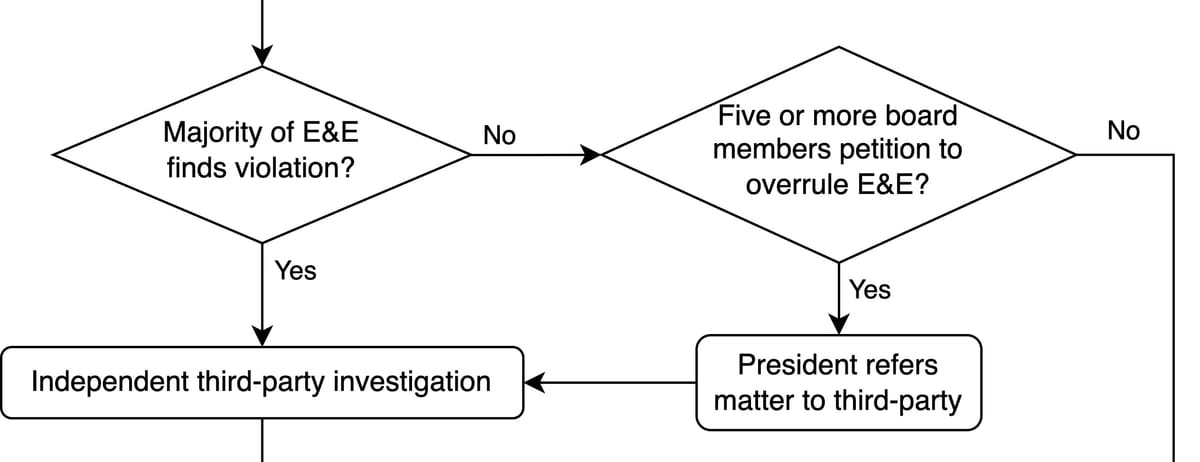ARRL E&E Reform: Proposed By-Law 46(e) Misses the Mark
An ARRL committee composed of division directors has spent a year building a process that's supposed to improve the handling of complaints relating to ethics and elections. These proposed changes are flawed and could undermine fairness, transparency, and trust in ARRL governance.

The ARRL’s proposed governance reforms — including a rewrite of by-law 46 — aim to address ethical, fiduciary, and legal violations by Board Members, but the true impact of these changes depends on the details of the plan and processes that will be used.
How does it do against our goals for excellence?
- Does it focus on real problems like perceptions and actual bias?
- Does it set clear expectations and remove ambiguity?
- Can the proposed process be maintained and enforced?
- Is the plan built on well-validated and proven best practices?
- Will it rebuild trust in the community?
Take a look at draft by-law 46(e). It is complex and convoluted. In the flowchart shown below, I have attempted to visually depict this process for better clarity. On a PC, you can move your mouse over the blocks in the diagram to see issues and concerns that came to mind for me.
Acknowledging the Effort
The ARRL should be commended for recognizing the need to formalize and improve processes around board member ethics, fiduciary responsibilities, and legal duties. Their proposed revisions to Bylaws 42 and 46 represent a step toward transparency and accountability. However, as any process of this nature must inspire confidence across all stakeholders, the current proposal falls short of establishing a robust and trust-building framework.
Most importantly, we can't ignore the elephant in the room: the inherent bias baked into the E&E’s structure. This isn’t just a historical footnote—it’s a persistent flaw that undermines the integrity of the entire process, including the changes proposed in Bylaw 46.
There are Major Gaps
The proposed system suffers from several critical deficiencies that undermine its effectiveness, fairness, and credibility, all of which compound long-standing issues with the E&E Committee. These gaps can be categorized into the following areas:
Fairness to All Parties
The proposal does not adequately ensure fairness for either the Reporting Party or the Subject Party:
- Ambiguity in Initial Steps: It is unclear how a complaint is filed, acknowledged, or initially assessed. This ambiguity creates potential for inconsistency in handling cases. Given the E&E’s historical opacity, members are right to question whether these steps will be applied evenly.
- Limited Rights of Appeal: The proposed process gives Reporting Parties no appeal mechanisms when violations are dismissed at early stages. This raises concerns about procedural fairness and reinforces perceptions of E&E control.
- Unclear Role of the Third Party: The introduction of a “neutral third party” seems like a step forward, but the execution leaves much to be desired. When the third party is selected, paid, and governed by the ARRL Board—which itself exerts significant influence over the E&E—how neutral can this party truly be?
Transparency and Trust
Stakeholder confidence is essential, particularly among ARRL members who are not directly involved in governance:
- Lack of Communication Protocols: There are no clear guidelines for how findings, progress, or resolutions are communicated to the Reporting Party, the Subject Party, or the general membership. Transparent reporting mechanisms would build trust and demonstrate accountability.
- The Appearance of Influence: When Board-appointed E&E members oversee cases with limited independent oversight, it reinforces perceptions that decisions could be swayed by internal power dynamics rather than an objective review of the facts.
Best Practices in Ethics Enforcement
The proposed process does not sufficiently address key elements of a robust enforcement system:
- Missing Clear Standards: The ARRL’s Board Member Statement of Authority, Responsibility, and Expectations lacks sufficient detail and enforceability to act as a meaningful code of conduct.
- Inadequate Confidentiality Protections: The absence of clear confidentiality safeguards leaves open questions about how sensitive information will be handled. This can undermine the integrity of the process and discourage Reporting Parties from coming forward.
- Inconsistent Enforcement: Without strong procedural frameworks, the process risks becoming inconsistent, with outcomes influenced by biases or internal politics. An effective enforcement model requires clear guidelines for every step, from complaint submission to resolution.
Uncertainty Around Binding Decisions
The proposed process does not explicitly state whether the determination of a violation by the third party is binding on the ARRL. This omission leaves a critical gap in the framework, as it fails to clarify the authority of the independent third party within the process.
- Lack of Clarity: The proposed by-laws are explicit in stating that the recommended remediation is not binding on the ARRL. However, they are silent on whether the existence or non-existence of a violation, as determined by the third party, is binding. This creates uncertainty about the weight and finality of the third party’s findings.
- Implications for Trust: If the ARRL retains the ability to dismiss or override the findings of the third party, this could undermine the perception of independence and neutrality that the third-party mechanism is intended to provide. Stakeholders may view the process as arbitrary or subject to internal influence.
- Potential for Disputes: Without explicit language clarifying the binding nature of violation determinations, disagreements about the scope and interpretation of findings could arise, leading to delays and further eroding confidence in the process.
Suggested Language Addition
To address this gap, the proposed by-laws should include explicit language regarding the binding or non-binding nature of the third party’s findings on the existence or non-existence of a violation. For example:
- “The determination by the independent third party regarding the existence or non-existence of a violation shall be binding on the ARRL.”
This would provide greater clarity, reduce the potential for disputes, and enhance trust in the process.
Recommended Changes
To address the gaps, the following changes are needed:
- Clarify and Codify Procedures: Provide detailed guidelines for filing, acknowledging, and assessing complaints, as well as timelines for each stage of the process.
- Enhance Transparency: Introduce protocols for regular updates to stakeholders and clear public reporting of aggregate case outcomes without compromising individual privacy.
- Strengthen Third-Party Oversight: Establish criteria for selecting and evaluating third-party investigators, ensuring their independence and neutrality.
- Reform the E&E Structure: Introduce member oversight or independent governance mechanisms to reduce the influence of Board politics on ethical investigations.
- Clarify the Role of the Third Party: Explicitly define whether the third party's determination of a violation is binding on the ARRL.
Conclusion
The ARRLs reform initiative is an important first step, but the proposed process requires significant refinement to meet the expectations of fairness, transparency, and trust. In its current form, the system risks alienating stakeholders and failing to provide the accountability it seeks to establish. By adopting the recommended changes, ARRL can create a model process that not only addresses ethical concerns but also strengthens the organization’s integrity and reputation.




